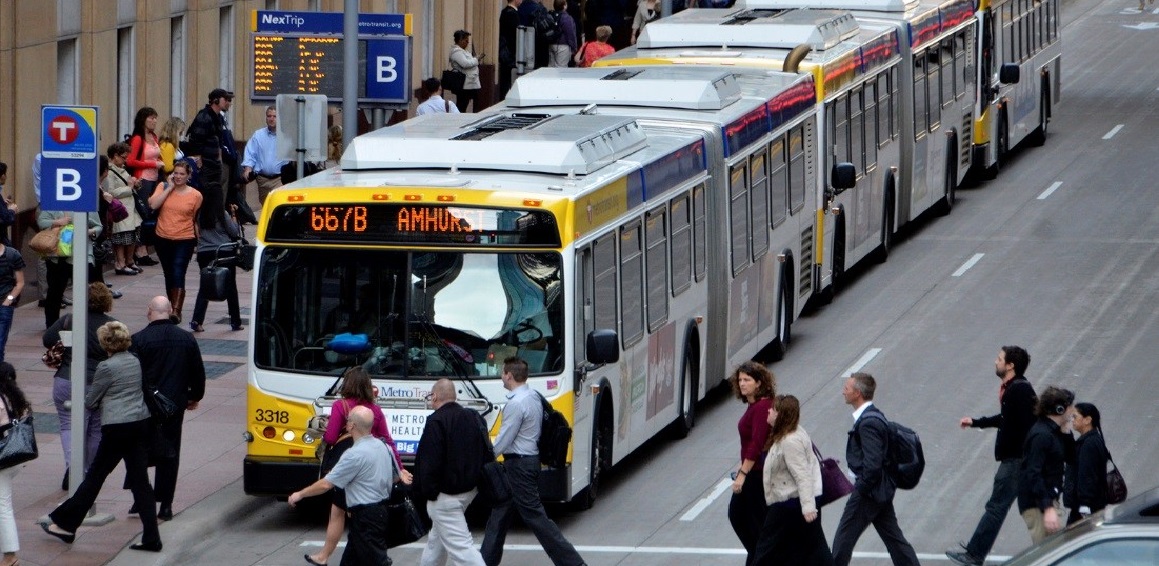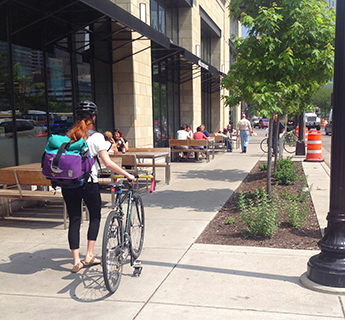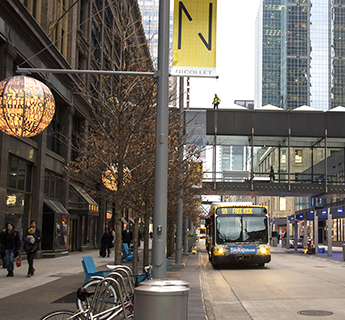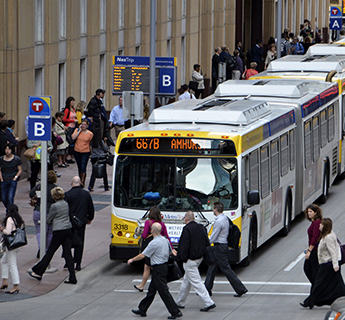Parking, Loading, and Mobility Regulations

On May 14, 2021, the City Council adopted a comprehensive overhaul of the city's parking, loading, and travel demand management zoning regulations. The amended regulations include the elements below.
- Eliminates minimum off-street parking requirements citywide.
- Incrementally lowers maximum parking allowances citywide.
- Increases bicycle parking requirements, and requirements for associated shower and locker facilities in large-scale developments.
- Establishes requirements for electrical vehicle charging infrastructure in new parking lots and structures.
- Amends the travel demand management (TDM) ordinance to apply more broadly and reorient regulations toward achieving the City’s climate goals, which includes having three out of every five trips taken in Minneapolis by walking, bicycling or transit.
The ordinance advances several Minneapolis 2040 goals, including climate change resilience and a clean environment by reducing reliance on cars and supporting the growth of electric vehicle infrastructure. It also promotes the goals of affordable and accessible housing and complete neighborhoods by improving the feasibility of development at varying scales in locations throughout Minneapolis.
Table of Contents
MINNEAPOLIS 2040 GOALS
Elimination of minimum parking requirements does not signal the end of development providing parking in Minneapolis. Paired with strengthened limits on maximum parking allowed, increased bicycle parking requirements, and a more consistent and robust travel demand management ordinance, these changes are intended to shift the city’s regulatory approach away from a focus on controlling the perceived negative externalities to development, and toward requiring and incentivizing the types of development that will reduce the occurrence of negative externalities in the first place. These amendments focus on achieving city mode split goals and goals to reduce greenhouse gas emissions, but also directly address the Minneapolis 2040 goals of…
- Climate change resilience and Clean environment through reduction on the reliance of automobiles, and supporting the growth of electric vehicle infrastructure.
- Affordable and accessible housing and Complete neighborhoods by improving the financial feasibility of development at varying scales in locations throughout Minneapolis.
- High-quality physical environment through design standards that support a variety of transportation modes.
- More residents and jobs by regulating the efficient use of land.
- Eliminate disparities by ensuring access to a variety of transportation options, technologies, and destinations through new development.
RESOURCES
- FINAL ADOPTED Parking, Loading, and Mobility Zoning Code Text Amendment - May 14, 2021
- DRAFT Parking, Loading, and Mobility Zoning Code Text Amendment - April 12, 2021
- DRAFT Parking, Loading, and Mobility Zoning Code Text Amendment - March 12, 2021
- Planning Commission Committee of the Whole Memo - March 11, 2021
- Planning Commission Committee of the Whole Presentation Slides - March 11, 2021
- Planning Commission Committee of the Whole Memo - August 20, 2020
TIMELINE
Planning Commission Committee of the Whole - March 11, 2021
Planning Commission Public Hearing – April 12, 2021
Business, Inspections, Housing, and Zoning Committee – May 4, 2021
City Council – May 14, 2021
Published Ordinance in Effect – May 22, 2021
RECOMMENDATIONS
Draft Parking, Loading, and Mobility ordinance language is available for review. A summary of the draft changes can be viewed by selected an element from the carousel below.
Staff welcomes feedback on the draft ordinance language. Please send comments via email to [email protected]. Comments will be included in the public record and presented to the City Planning Commission at the public hearing scheduled for April 12, 2021.
Minimum Parking
Maximum Parking
Bicycle Parking and Facilities
Electric Vehicle Charging
Loading
Travel Demand Management
RATIONALE
Parking and Loading ordinance reform is aimed at achieving the policy goals in Minneapolis 2040 and the Transportation Action Plan, and is supported by the findings of a wide variety of publications and academic research. Ordinance reform also aligns with related efforts to generally improve the built environment in a manner that is supportive of alternative forms of transportation.
- The cost of producing parking is paid for by residential owners and renters, whether they use it or not. This results in inflated housing costs, particularly for lower income households. [citation]
- Providing an overabundance of parking incentivizes automobile use at the expense of more efficient and environmentally friendly forms of transportation. This ultimately results in greater demands being placed on roadways and an increase in greenhouse gas emissions. [citation 1, 2]
- Dedication of large portions of land to inactive uses such as parking reduces the efficiency with which land is used, reducing the ability of residents to satisfy their daily transportation needs within a small geographic footprint.
- Walkable urban design best practices are made less effective when they must accommodate parking, drive aisles, and curb cuts for automobiles.
- Parking reform has the added benefit of reducing the number of staff hours spent administering parking-related provisions in the zoning ordinance, with the intended trade-off of spending more time working with developers and businesses to meet the City’s transportation goals.
- Regulatory relief for businesses is also intended with these changes. Much of the built environment in Minneapolis predates the proliferation of automobile use, and as such many existing properties do not have existing dedicated parking. Eliminating requirements can make it easier for businesses to establish themselves in existing properties throughout Minneapolis.
Minneapolis 2040 and the Transportation Action Plan highlight a series of transportation goals. The following review focuses on the Travel Demand Management (TDM) practices that have the greatest impact on achieving those goals, particularly as they relate to reducing greenhouse gas emissions. These goals can primarily be achieved through encouraging mode shift away from single occupancy vehicles to other forms of transportation. A review by the Federal Highway Administration highlights the importance of acknowledging that most effects of TDM best practices are very local, and are difficult to evaluate at a citywide or even corridor level. [citation] Other actions and investments by government entities are needed to maximize the impacts of TDM plans. Minneapolis 2040 and the Transportation Action Plan addresses many of these other actions that are necessary such as provision of adequate pedestrian, bicycle, and transit infrastructure, and transit supportive development regulations.
Strategies to address travel demand brought on by new development typically fall into a small handful of categories.
- Support, promotion of, or information related to alternative forms of transportation
- Direct provision of alternative forms of transportation
- Financial incentives and physical improvements aimed at encouraging users to choose other forms of transportation
When paired with provision of a strong public transit system, supportive land uses, and streets designed to accommodate varied modes of transportation, these strategies become more effective. Conversely, when abundant and free parking is provided, these strategies become less effective. [citation]
This is important context to consider when adopting strategies that will be most effective in Minneapolis. Studies and literature reviews highlight the primary importance of development occurring within an existing land use framework with a mix of uses and/or transit service. These conditions are present in Minneapolis to a greater extent than anywhere else in the metro area. Development within Minneapolis by its nature will produce fewer single occupancy vehicle trips and induce fewer greenhouse gas emissions than development elsewhere in the region. Travel demand management best practices should therefore be seen as existing in the greater context of a supportive land use and built form policy and transit investment framework. In that light, staff proposes TDM requirements that will supplement larger efforts to support walking, cycling, and transit – these regulations should not be seen as working in a vacuum to achieve the city’s transportation and climate action goals.
HISTORY OF PARKING REFORM IN MINNEAPOLIS
Minneapolis has amended parking regulations regularly in the past twenty years, incrementally changing the amount of parking required for various types of development and in varying locations throughout the city. Select locations in Minneapolis have had no minimum parking requirement for over ten years, and parking requirements for more geographies have been incrementally eliminated over time. Based on experience reviewing projects in these locations, staff expects that parking will still be built in many developments, so these amendments are also intended to address how developments can otherwise help to achieve the City’s transportation goals.
1999
Downtown Parking Overlay District is adopted, prohibited new commercial parking lots and introduced restrictions on new surface lots downtown
2004
Transit Station Area Pedestrian Oriented Overlay Districts are adopted, prohibited new commercial parking lots near light rail stations
2009
Parking reform package that included
- Reduced parking requirements for commercial uses, requiring zero spaces for smaller establishments
- Maximum parking standards adopted citywide
- Minimum bicycle parking requirements established for most uses
- Eliminated minimum parking requirements in the downtown zoning districts
2015
Parking reform package that included
- Elimination of parking requirement for residential buildings with 3 – 50 units located near high frequency transit, 50 percent reduction for larger residential buildings
- Ten percent reduction in parking requirements for residential buildings in proximity to standard transit service
2016
On select corridors, nonresidential uses no longer required to provide off-street parking
2017
New limits on the amount of parking frontage allowed on any floor facing public streets, applies primarily to parking garages in larger buildings
2019
Minneapolis 2040 is adopted, signaling the City’s intent to eliminate parking minimums, evaluate and institute parking maximums, and revamp the travel demand management ordinance.








